2023 TOYOTA 86 warning
[x] Cancel search: warningPage 169 of 449
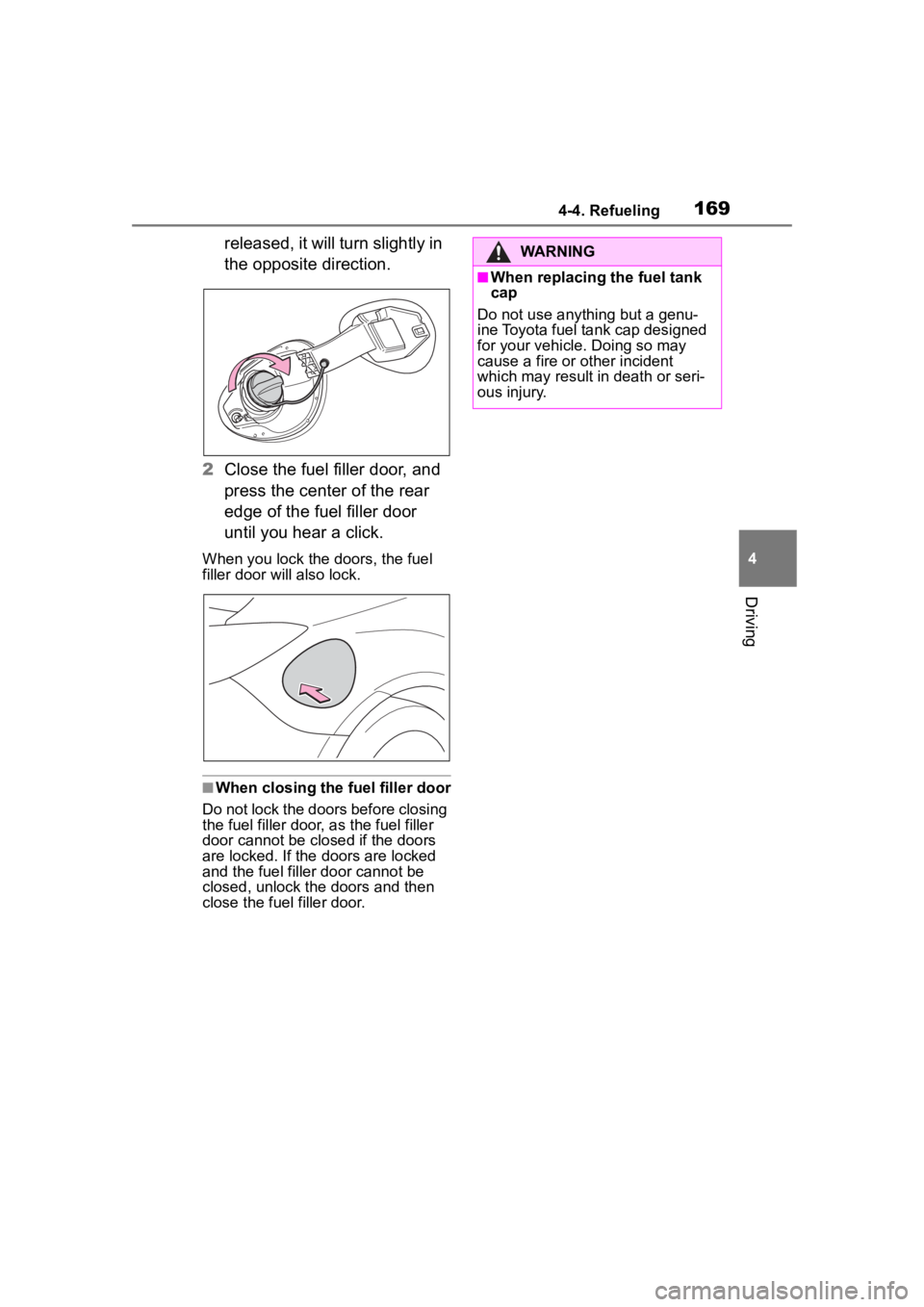
1694-4. Refueling
4
Driving
released, it will turn slightly in
the opposite direction.
2 Close the fuel filler door, and
press the center of the rear
edge of the fuel filler door
until you hear a click.
When you lock the doors, the fuel
filler door will also lock.
■When closing the fuel filler door
Do not lock the doors before closing
the fuel filler door , as the fuel filler
door cannot be closed if the doors
are locked. If the doors are locked
and the fuel filler door can not be
closed, unlock the doors and then
close the fuel filler door.
WARNING
■When replacing the fuel tank
cap
Do not use anything but a genu-
ine Toyota fuel tank cap designed
for your vehicle. Doing so may
cause a fire or other incident
which may result i n death or seri-
ous injury.
Page 170 of 449
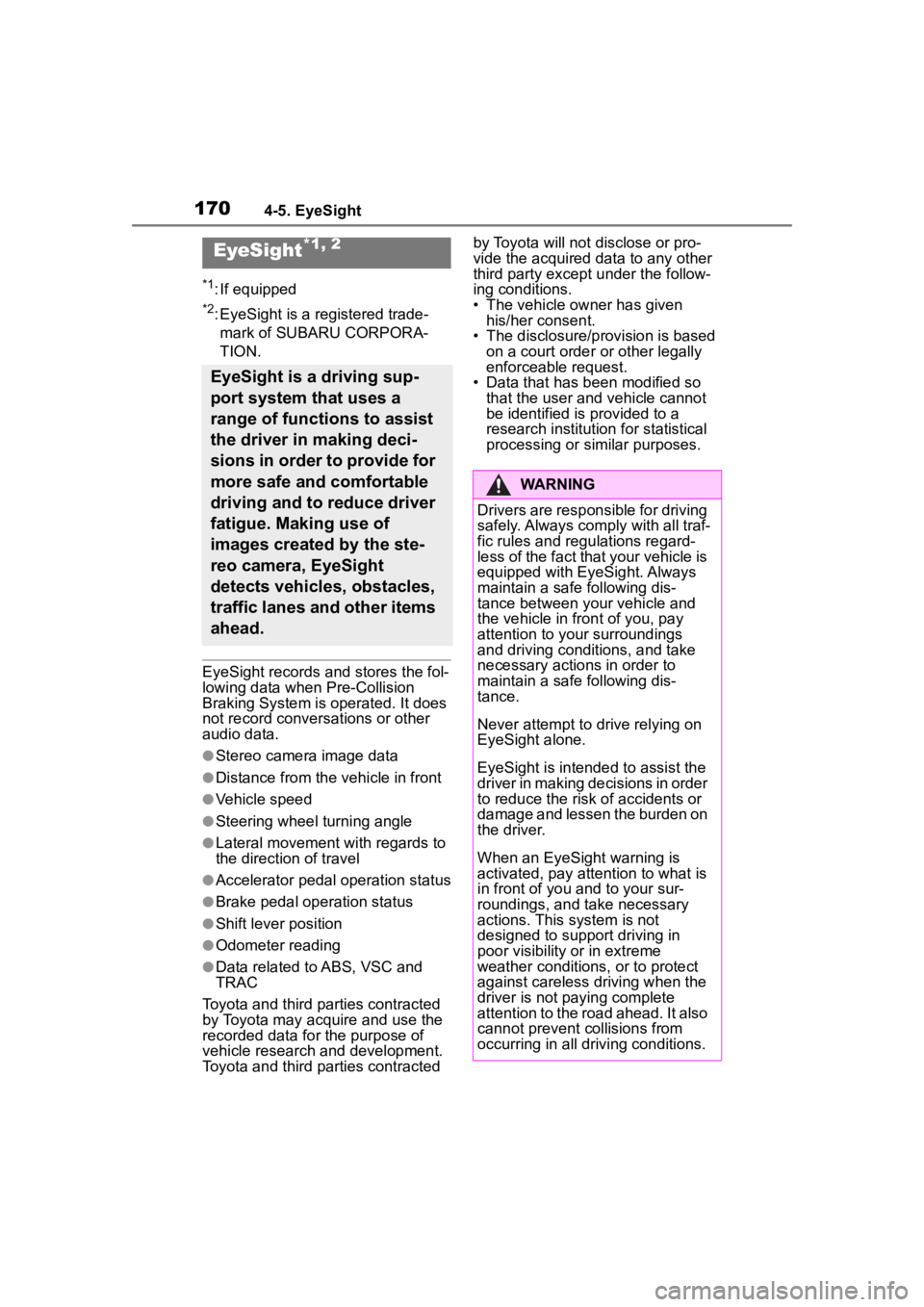
1704-5. EyeSight
4-5.EyeSight
*1: If equipped
*2: EyeSight is a registered trade-mark of SUBARU CORPORA-
TION.
EyeSight records a nd stores the fol-
lowing data when Pre-Collision
Braking System is operated. It does
not record conversations or other
audio data.
●Stereo camera image data
●Distance from the vehicle in front
●Vehicle speed
●Steering wheel turning angle
●Lateral movement with regards to
the direction of travel
●Accelerator pedal operation status
●Brake pedal operation status
●Shift lever position
●Odometer reading
●Data related to ABS, VSC and
TRAC
Toyota and third parties contracted
by Toyota may acquire and use the
recorded data for the purpose of
vehicle research and development.
Toyota and third parties contracted by Toyota will not disclose or pro-
vide the acquired data to any other
third party except under the follow-
ing conditions.
• The vehicle owner has given
his/her consent.
• The disclosure/provision is based on a court order or other legally
enforceable request.
• Data that has been modified so that the user and vehicle cannot
be identified is provided to a
research instituti on for statistical
processing or similar purposes.
EyeSight*1, 2
EyeSight is a driving sup-
port system that uses a
range of functions to assist
the driver in making deci-
sions in order to provide for
more safe and comfortable
driving and to reduce driver
fatigue. Making use of
images created by the ste-
reo camera, EyeSight
detects vehicles, obstacles,
traffic lanes and other items
ahead.
WARNING
Drivers are responsible for driving
safely. Always comply with all traf-
fic rules and regulations regard-
less of the fact that your vehicle is
equipped with EyeSight. Always
maintain a safe following dis-
tance between your vehicle and
the vehicle in front of you, pay
attention to your surroundings
and driving condi tions, and take
necessary actions in order to
maintain a safe following dis-
tance.
Never attempt to d rive relying on
EyeSight alone.
EyeSight is intended to assist the
driver in making decisions in order
to reduce the risk of accidents or
damage and lessen the burden on
the driver.
When an EyeSight warning is
activated, pay attention to what is
in front of you and to your sur-
roundings, and take necessary
actions. This system is not
designed to support driving in
poor visibility or in extreme
weather conditions, or to protect
against careless driving when the
driver is not paying complete
attention to the road ahead. It also
cannot prevent c ollisions from
occurring in all driving conditions.
Page 171 of 449
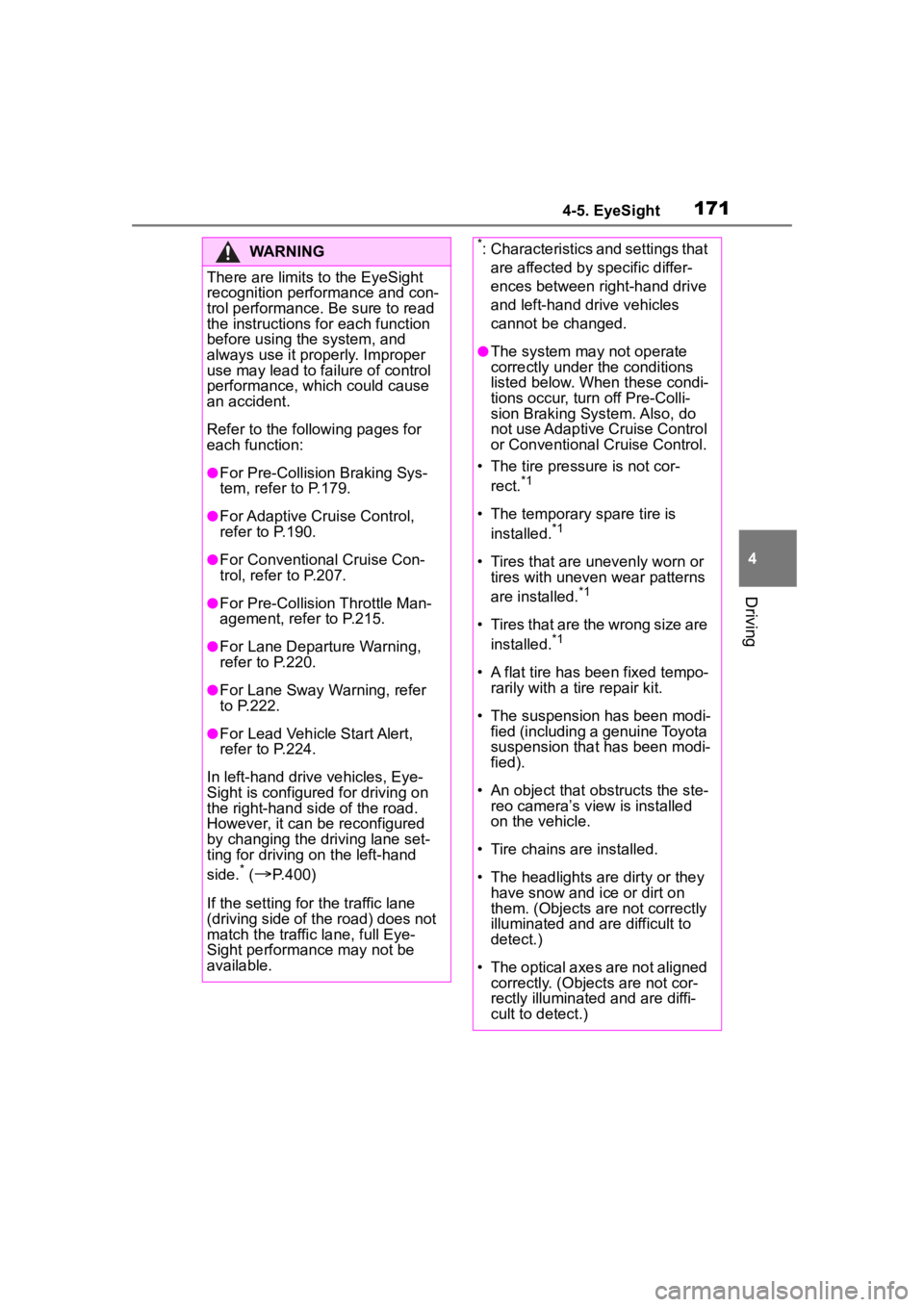
1714-5. EyeSight
4
Driving
WARNING
There are limits to the EyeSight
recognition performance and con-
trol performance. Be sure to read
the instructions for each function
before using the system, and
always use it properly. Improper
use may lead to failure of control
performance, which could cause
an accident.
Refer to the fo llowing pages for
each function:
●For Pre-Collision Braking Sys-
tem, refer to P.179.
●For Adaptive Cruise Control,
refer to P.190.
●For Conventional Cruise Con-
trol, refer to P.207.
●For Pre-Collision Throttle Man-
agement, refer to P.215.
●For Lane Departure Warning,
refer to P.220.
●For Lane Sway Warning, refer
to P.222.
●For Lead Vehicle Start Alert,
refer to P.224.
In left-hand drive vehicles, Eye-
Sight is configured for driving on
the right-hand side of the road.
However, it can be reconfigured
by changing the driving lane set-
ting for driving o n the left-hand
side.
* (P.400)
If the setting for the traffic lane
(driving side of the road) does not
match the traffic lane, full Eye-
Sight performance may not be
available.
*: Characteristics and settings that are affected by specific differ-
ences between right-hand drive
and left-hand drive vehicles
cannot be changed.
●The system may not operate
correctly under the conditions
listed below. When these condi-
tions occur, turn off Pre-Colli-
sion Braking Sy stem. Also, do
not use Adaptive Cruise Control
or Conventional Cruise Control.
• The tire pressure is not cor- rect.
*1
• The temporary spare tire is installed.*1
• Tires that are unevenly worn or tires with uneven wear patterns
are installed.
*1
• Tires that are the wrong size are
installed.*1
• A flat tire has been fixed tempo-rarily with a tire repair kit.
• The suspension has been modi- fied (including a genuine Toyota
suspension that has been modi-
fied).
• An object that obstructs the ste- reo camera’s view is installed
on the vehicle.
• Tire chains are installed.
• The headlights are dirty or they have snow and ice or dirt on
them. (Objects are not correctly
illuminated and are difficult to
detect.)
• The optical axes are not aligned correctly. (Objects are not cor-
rectly illuminated and are diffi-
cult to detect.)
Page 172 of 449
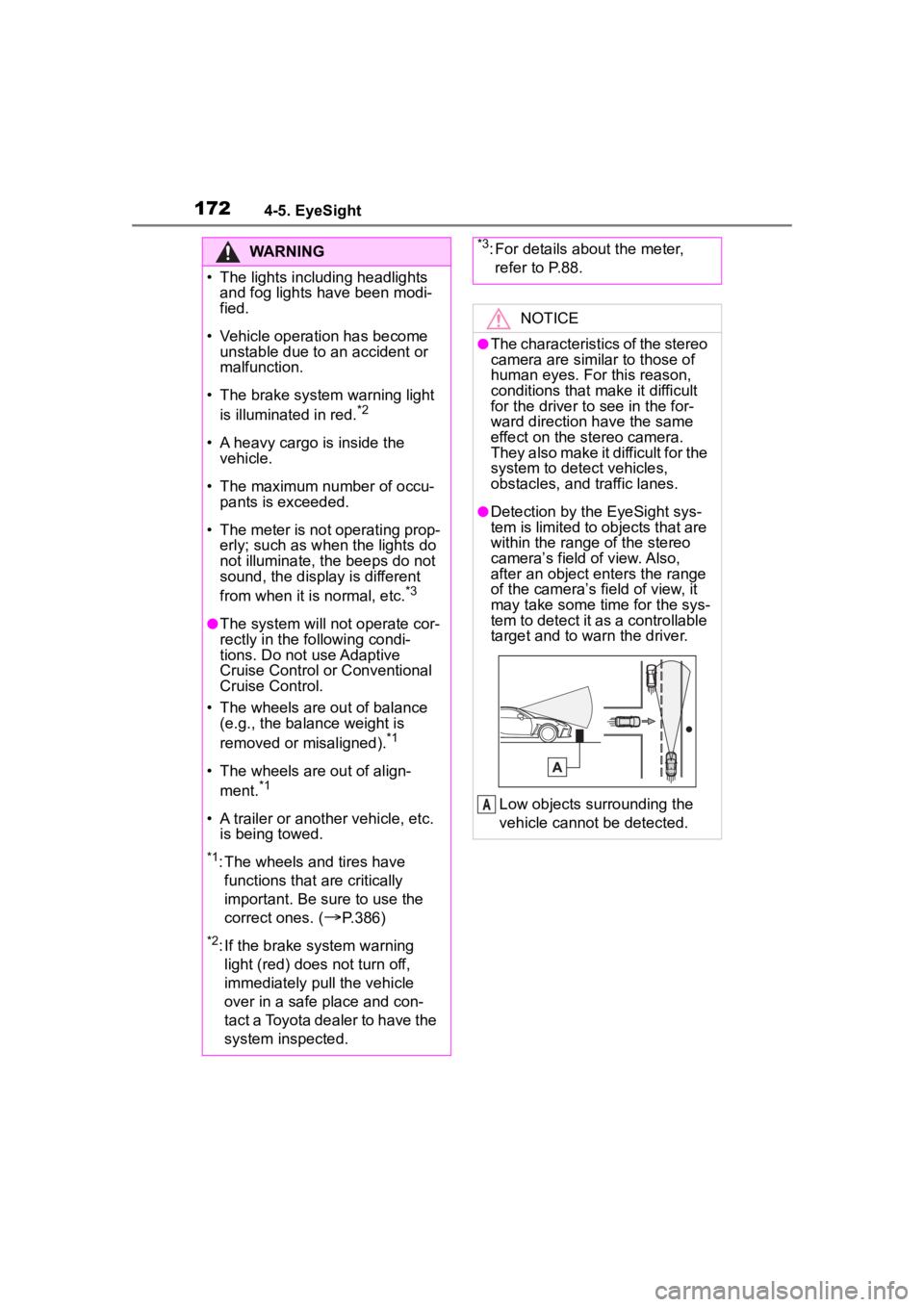
1724-5. EyeSight
WARNING
• The lights including headlights and fog lights have been modi-
fied.
• Vehicle operation has become unstable due to an accident or
malfunction.
• The brake system warning light is illuminated in red.
*2
• A heavy cargo is inside the vehicle.
• The maximum number of occu- pants is exceeded.
• The meter is not operating prop- erly; such as when the lights do
not illuminate, the beeps do not
sound, the display is different
from when it is normal, etc.
*3
●The system will not operate cor-
rectly in the following condi-
tions. Do not use Adaptive
Cruise Control or Conventional
Cruise Control.
• The wheels are out of balance (e.g., the balance weight is
removed or misaligned).
*1
• The wheels are out of align-
ment.*1
• A trailer or another vehicle, etc. is being towed.
*1: The wheels and tires have
functions that are critically
important. Be sure to use the
correct ones. (
P.386)
*2: If the brake system warning
light (red) does not turn off,
immediately pull the vehicle
over in a safe place and con-
tact a Toyota dealer to have the
system inspected.
*3: For details about the meter, refer to P.88.
NOTICE
●The characteristics of the stereo
camera are simila r to those of
human eyes. For this reason,
conditions that make it difficult
for the driver to see in the for-
ward direction have the same
effect on the stereo camera.
They also make it difficult for the
system to detect vehicles,
obstacles, and traffic lanes.
●Detection by the EyeSight sys-
tem is limited to objects that are
within the range of the stereo
camera’s field of view. Also,
after an object enters the range
of the camera’s field of view, it
may take some time for the sys-
tem to detect it as a controllable
target and to warn the driver.
Low objects surrounding the
vehicle cannot be detected.
A
Page 174 of 449
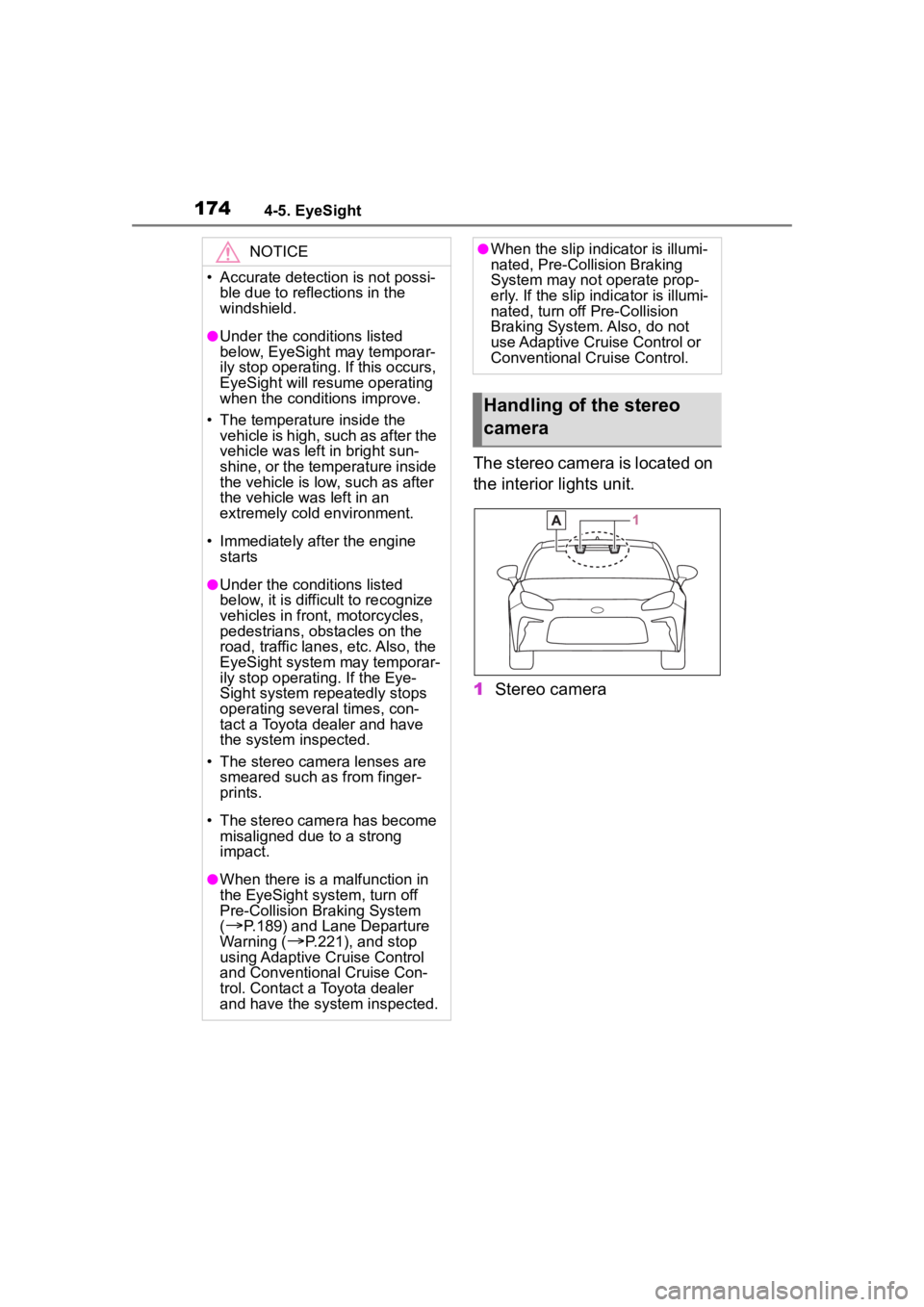
1744-5. EyeSight
The stereo camera is located on
the interior lights unit.
1Stereo camera
NOTICE
• Accurate detecti on is not possi-
ble due to reflections in the
windshield.
●Under the conditions listed
below, EyeSight may temporar-
ily stop operating. If this occurs,
EyeSight will resume operating
when the conditions improve.
• The temperature inside the vehicle is high, such as after the
vehicle was left in bright sun-
shine, or the temperature inside
the vehicle is low, such as after
the vehicle was left in an
extremely cold environment.
• Immediately after the engine starts
●Under the conditions listed
below, it is difficult to recognize
vehicles in front, motorcycles,
pedestrians, obstacles on the
road, traffic lanes, etc. Also, the
EyeSight system may temporar-
ily stop operating. If the Eye-
Sight system repeatedly stops
operating several times, con-
tact a Toyota dealer and have
the system inspected.
• The stereo camera lenses are smeared such as from finger-
prints.
• The stereo camera has become misaligned due to a strong
impact.
●When there is a malfunction in
the EyeSight system, turn off
Pre-Collision Br aking System
(
P.189) and Lane Departure
Warning (
P.221), and stop
using Adaptive Cruise Control
and Conventional Cruise Con-
trol. Contact a Toyota dealer
and have the system inspected.
●When the slip indicator is illumi-
nated, Pre-Collision Braking
System may not operate prop-
erly. If the slip indicator is illumi-
nated, turn off Pre-Collision
Braking System. Also, do not
use Adaptive Cruise Control or
Conventional Cruise Control.
Handling of the stereo
camera
Page 177 of 449
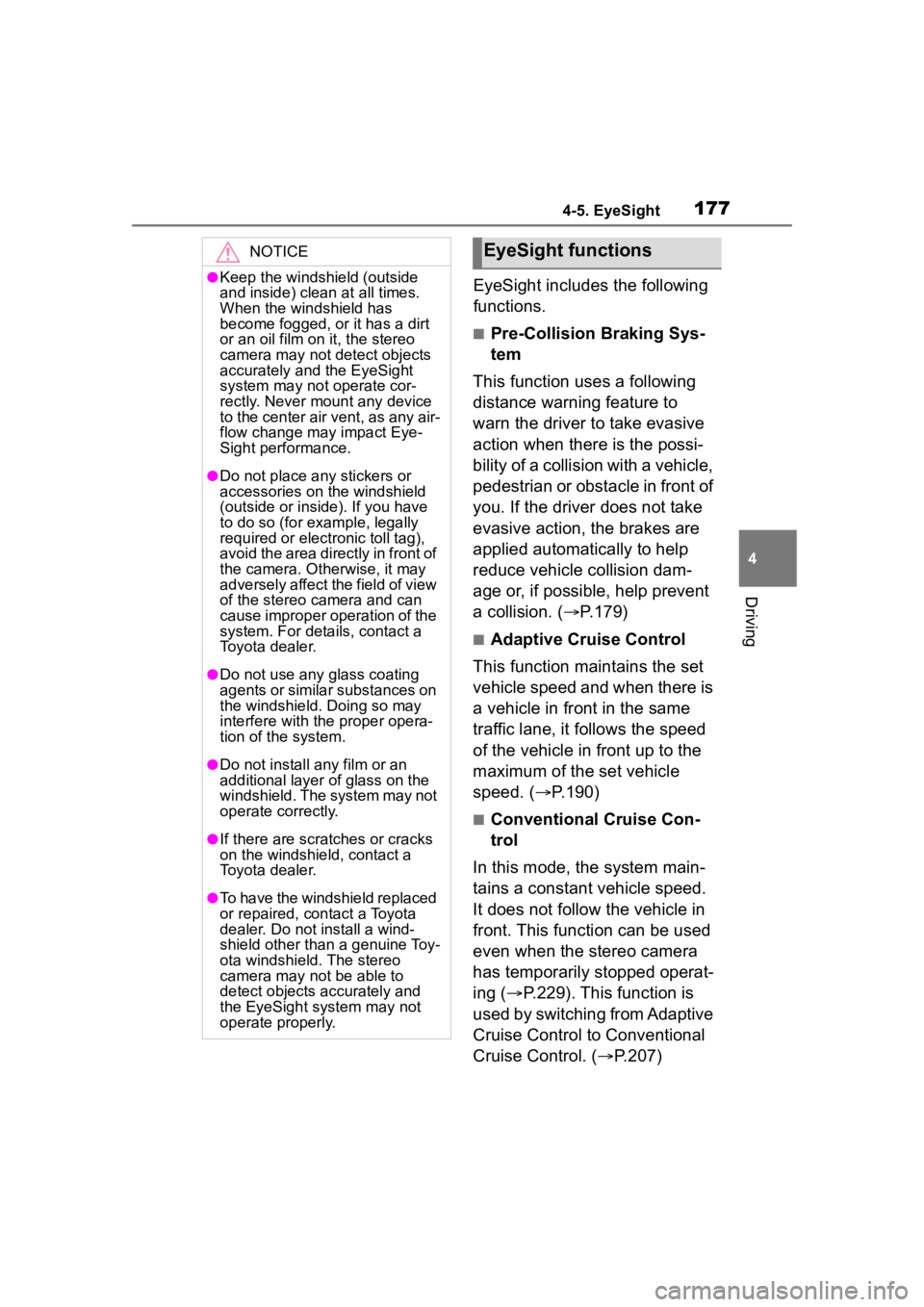
1774-5. EyeSight
4
Driving
EyeSight includes the following
functions.
■Pre-Collision Braking Sys-
tem
This function uses a following
distance warning feature to
warn the driver to take evasive
action when there is the possi-
bility of a collision with a vehicle,
pedestrian or obstacle in front of
you. If the driver does not take
evasive action, the brakes are
applied automatically to help
reduce vehicle collision dam-
age or, if possible, help prevent
a collision. ( P.179)
■Adaptive Cruise Control
This function maintains the set
vehicle speed and when there is
a vehicle in front in the same
traffic lane, it follows the speed
of the vehicle in front up to the
maximum of the set vehicle
speed. ( P.190)
■Conventional Cruise Con-
trol
In this mode, the system main-
tains a constant vehicle speed.
It does not follow the vehicle in
front. This function can be used
even when the stereo camera
has temporarily stopped operat-
ing ( P.229). This function is
used by switching from Adaptive
Cruise Control to Conventional
Cruise Control. ( P.207)
NOTICE
●Keep the windshield (outside
and inside) clean at all times.
When the windshield has
become fogged, or it has a dirt
or an oil film on it, the stereo
camera may not detect objects
accurately and the EyeSight
system may not operate cor-
rectly. Never mount any device
to the center air vent, as any air-
flow change may impact Eye-
Sight performance.
●Do not place any stickers or
accessories on the windshield
(outside or inside). If you have
to do so (for example, legally
required or electronic toll tag),
avoid the area directly in front of
the camera. Otherwise, it may
adversely affect the field of view
of the stereo camera and can
cause improper operation of the
system. For details, contact a
Toyota dealer.
●Do not use any glass coating
agents or similar substances on
the windshield. Doing so may
interfere with the proper opera-
tion of the system.
●Do not install any film or an
additional layer of glass on the
windshield. The system may not
operate correctly.
●If there are scratches or cracks
on the windshield, contact a
Toyota dealer.
●To have the windshield replaced
or repaired, contact a Toyota
dealer. Do not install a wind-
shield other than a genuine Toy-
ota windshield. The stereo
camera may not be able to
detect objects accurately and
the EyeSight system may not
operate properly.
EyeSight functions
Page 178 of 449
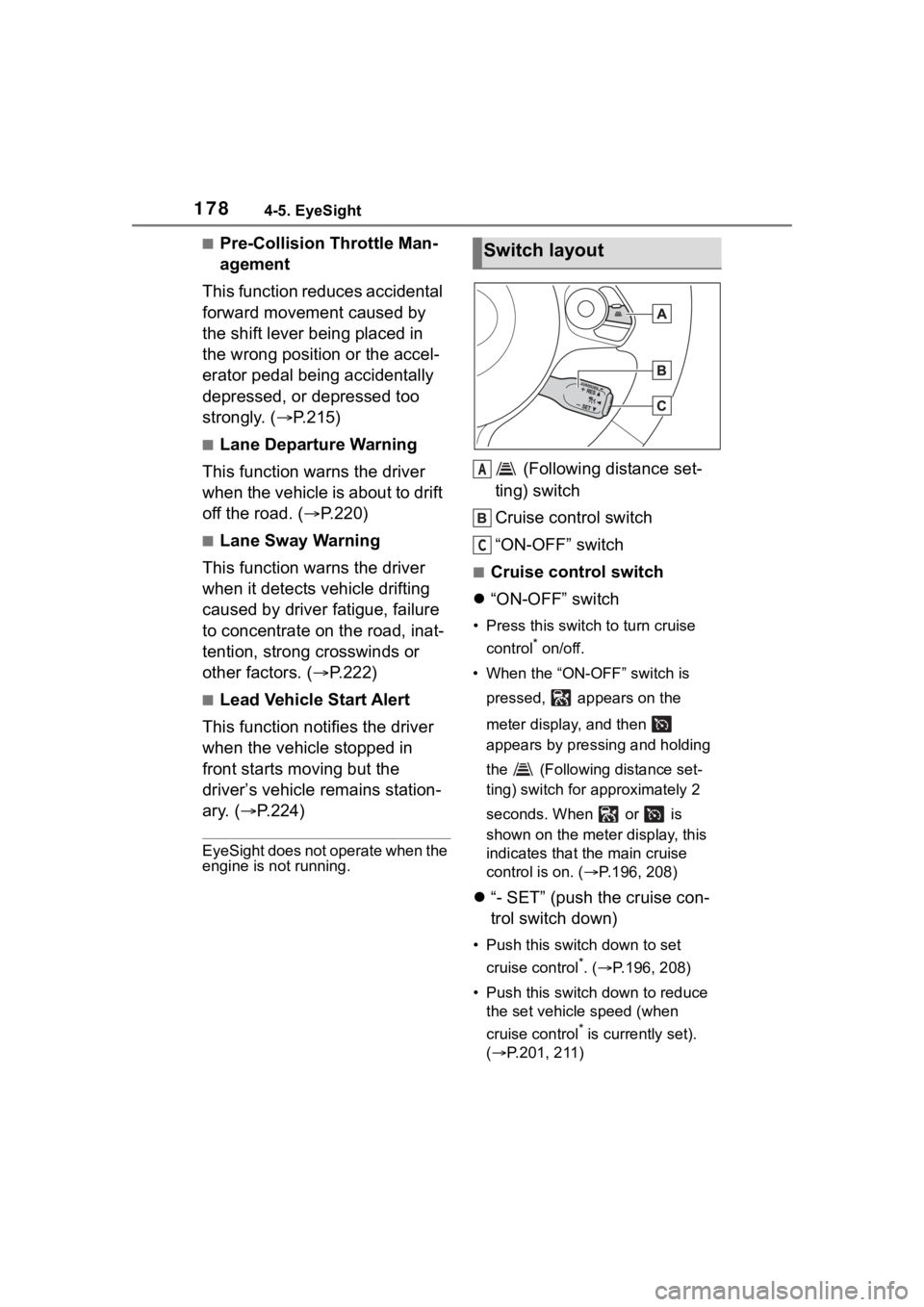
1784-5. EyeSight
■Pre-Collision Throttle Man-
agement
This function reduces accidental
forward movement caused by
the shift lever being placed in
the wrong position or the accel-
erator pedal being accidentally
depressed, or depressed too
strongly. ( P.215)
■Lane Departure Warning
This function warns the driver
when the vehicle is about to drift
off the road. ( P.220)
■Lane Sway Warning
This function warns the driver
when it detects vehicle drifting
caused by driver fatigue, failure
to concentrate on the road, inat-
tention, strong crosswinds or
other factors. ( P.222)
■Lead Vehicle Start Alert
This function notifies the driver
when the vehicle stopped in
front starts moving but the
driver’s vehicle remains station-
ary. ( P.224)
EyeSight does not operate when the
engine is not running.
(Following distance set-
ting) switch
Cruise control switch
“ON-OFF” switch
■Cruise control switch
“ON-OFF” switch
• Press this switch to turn cruise
control
* on/off.
• When the “ON-OFF” switch is pressed, appears on the
meter display, and then
appears by pressing and holding
the (Following distance set-
ting) switch for a pproximately 2
seconds. When or is
shown on the meter display, this
indicates that the main cruise
control is on. ( P.196, 208)
“- SET” (push the cruise con-
trol switch down)
• Push this switch down to set
cruise control
*. ( P.196, 208)
• Push this switch down to reduce the set vehicle speed (when
cruise control
* is currently set).
( P.201, 211)
Switch layout
A
C
Page 179 of 449
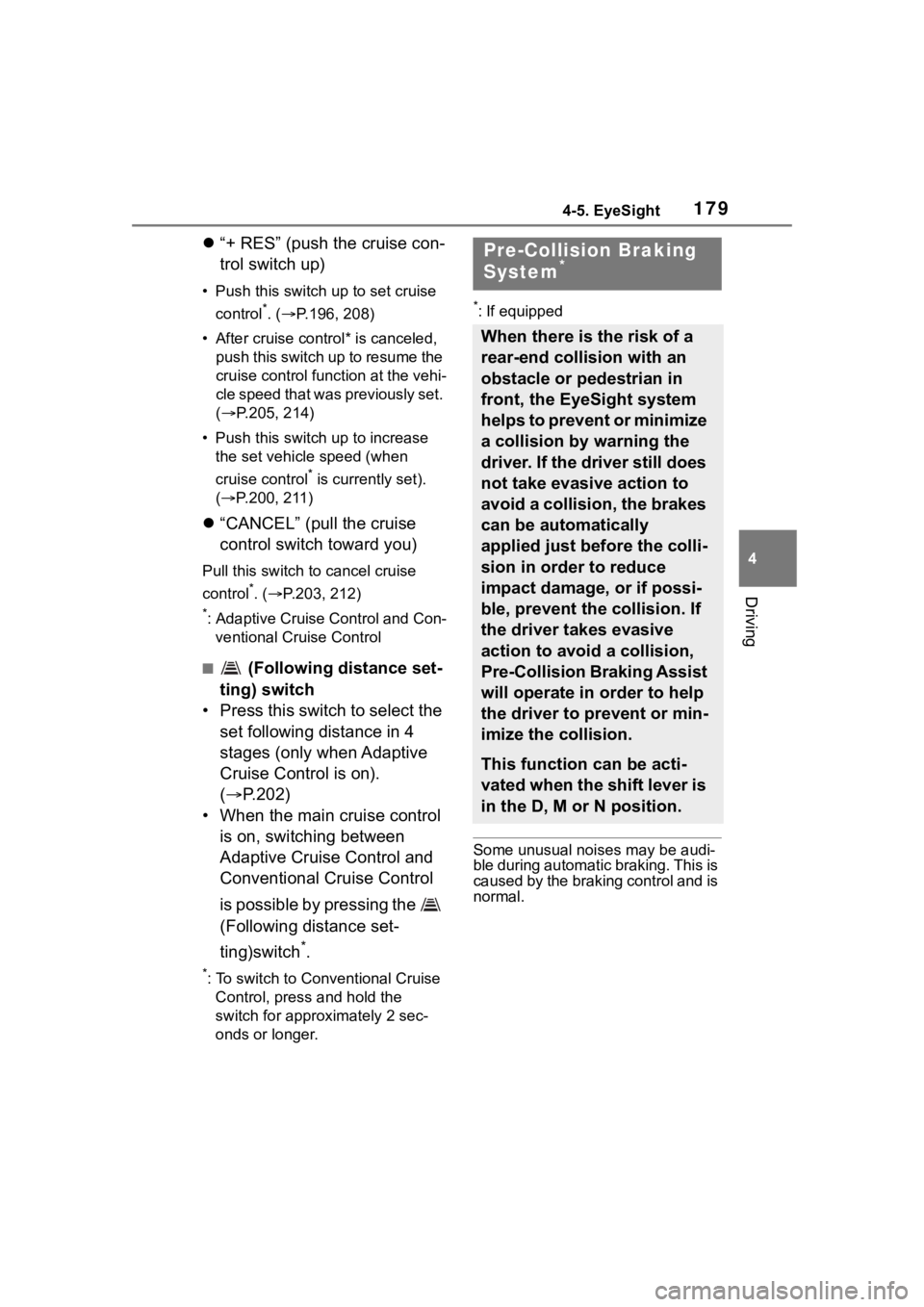
1794-5. EyeSight
4
Driving
“+ RES” (push the cruise con-
trol switch up)
• Push this switch up to set cruise
control
*. ( P.196, 208)
• After cruise control* is canceled, push this switch up to resume the
cruise control function at the vehi-
cle speed that was previously set.
( P.205, 214)
• Push this switch up to increase the set vehicle speed (when
cruise control
* is currently set).
( P.200, 211)
“CANCEL” (pull the cruise
control switch toward you)
Pull this switch to cancel cruise
control
*. ( P.203, 212)
*: Adaptive Cruise Control and Con-
ventional Cruise Control
■ (Following distance set-
ting) switch
• Press this switch to select the set following distance in 4
stages (only when Adaptive
Cruise Control is on).
( P.202)
• When the main cruise control is on, switching between
Adaptive Cruise Control and
Conventional Cruise Control
is possible by pressing the
(Following distance set-
ting)switch
*.
*: To switch to Conventional Cruise Control, press and hold the
switch for appro ximately 2 sec-
onds or longer.
*: If equipped
Some unusual noises may be audi-
ble during automatic braking. This is
caused by the braking control and is
normal.
Pre-Collision Braking
System*
When there is the risk of a
rear-end collision with an
obstacle or pedestrian in
front, the EyeSight system
helps to prevent or minimize
a collision by warning the
driver. If the driver still does
not take evasive action to
avoid a collision, the brakes
can be automatically
applied just before the colli-
sion in order to reduce
impact damage, or if possi-
ble, prevent the collision. If
the driver takes evasive
action to avoid a collision,
Pre-Collision Braking Assist
will operate in order to help
the driver to prevent or min-
imize the collision.
This function can be acti-
vated when the shift lever is
in the D, M or N position.